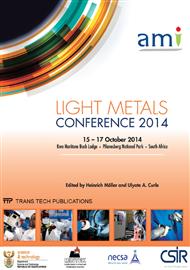[1]
Lijia Hea, A. Dehghan-Manshadi, R.J. Dippenaar. The evolution of microstructure of Ti–6Al–4V alloy during concurrent hot deformation and phase transformation. Materials Science and Engineering A. 549(2012)163-167.
DOI: 10.1016/j.msea.2012.04.025
Google Scholar
[2]
T. Seshacharyulu, S.C.M., J.T. Morgan, J.C. Malas, W.G. Frazier Y.V.R.K. Prasad. Hot deformation and microstructural damage mechanisms in extra-low interstitial (ELI) grade Ti–6Al–4V. Materials Science and Engineering A. 279(2000)289–299.
DOI: 10.1016/s0921-5093(99)00173-2
Google Scholar
[3]
T. Seshacharyulu, S.C.M., W.G. Frazier, Y.V.R.K. Prasad. Hot working of commercial Ti–6Al–4V with an equiaxed microstructure: materials modeling considerations. Materials Science and Engineering A. 284(2000)184–194.
DOI: 10.1016/s0921-5093(00)00741-3
Google Scholar
[4]
Seshacharyulu T, Medeiros S. C, Frazier W. G, Prasad Y.V.R.K. Microstructural mechanisms during hot working of commercial grade Ti-6Al-4V with lamellar starting structure. Materials Science and Engineering. 325(2002) , 325.
DOI: 10.1016/s0921-5093(01)01448-4
Google Scholar
[5]
Chan Hee Park1, Kyung-Tae Park, Dong Hyuk Shin, Chong Soo Lee. Microstructural Mechanisms during Dynamic Globularization of Ti-6Al-4V Alloy. Materials Transactions. 10(2008) 2196-2200.
DOI: 10.2320/matertrans.l-mra2008832
Google Scholar
[6]
Mei ZHAN, Qiaoling WANG, Dong HAN, He YANG. Geometric precision and microstructure evolution of TA15 alloy by hot shear spinning. Transactions of Nonferrous Metals Society of China. 23(2013)1617-1627.
DOI: 10.1016/s1003-6326(13)62639-4
Google Scholar
[7]
J.L.W. Warwick, N.G. Jones, I. Bantounas, M. Preuss, D. Dye. In situ observation of texture and microstructure evolution during rolling and globularization of Ti–6Al–4V. Acta Materialia. 61(2013)1603-1615.
DOI: 10.1016/j.actamat.2012.11.037
Google Scholar
[8]
Shibayan Roy, Satyam Suwas. The influence of temperature and strain rate on the deformation response and microstructural evolution during hot compression of a titanium alloy Ti–6Al–4V–0. 1B. Journal of Alloys and Compounds, 548(2013)110-125.
DOI: 10.1016/j.jallcom.2012.08.123
Google Scholar
[9]
Wang Min, Guo Hongzhen. Study on superplasticity and fine-grained of TC4 alloy. Journal of Plasticity Engineering. 15(2008)155-158.
Google Scholar
[10]
Xue Chao, Hu Jianjun, Chen Guoqing, Zhou Wenlong, Zhang Jiuwen. Recovery and Recrystallization Behavior of Ti6Al4V Alloys after Cold Deformation. Rare Metal Materials and Engineering. 41(2012)472-476.
Google Scholar
[11]
A.B. Li, L.J. Huang, Q.Y. Meng, L. Geng, X.P. Cui. Hot working of Ti–6Al–3Mo–2Zr–0. 3Si alloy with lamellar α + β starting structure using processing map. Mater. Des. 30 (2009)1625–1631.
DOI: 10.1016/j.matdes.2008.07.031
Google Scholar
[12]
S.L. Semiatin, V. Seetharaman, I. Weiss. Flow behavior and globalarization kinetics during hot working of Ti-6Al-4V with a colony alpha microstructure[J]. Mater Sci Eng A, 1999, 263: 257-271.
DOI: 10.1016/s0921-5093(98)01156-3
Google Scholar
[13]
Wenwen Peng, W. Z., Qingjiang Wang, Qinyang Zhao, Hanqing Yu. Effect of processing parameters on hot deformation behavior and microstructural evolution during hot compression of as-cast Ti60 titanium alloy. Materials Science & Engineering A. 593 (2014).
DOI: 10.1016/j.msea.2013.07.086
Google Scholar
[14]
Murty S V S N, Rao B N, Kashyap B P. Instability criteria for hot deformation of materials. International Materials Reviews. 45(2000)15 -26.
DOI: 10.1179/095066000771048782
Google Scholar
[15]
Prasad Y V R K, Seshacharyulu T. Processing maps for hot working of titanium alloys. Materials Science and Engineering A. 243(1998)82-88.
DOI: 10.1016/s0921-5093(97)00782-x
Google Scholar
[16]
V. Gopala Krishna, Y.V.R.K. Prasad, N.C. Birla, G. Sambasiva Rao. Processing map for the hot working of near-α titanium alloy 685. Journal of Materials Processing Technology. 71(1997)377-383.
DOI: 10.1016/s0924-0136(97)00102-7
Google Scholar
[17]
S.V.S. Narayana Murty, B. Nageswara Rao. On the flow localization concepts in the processing maps of IN718. Materials Science and Engineering A. 267(1999)159-161.
DOI: 10.1016/s0921-5093(99)00122-7
Google Scholar
[18]
Y.V.R.K. Prasad, T. Seshacharyulu, S.C. Medeiros, W.G. Frazier. Infuence of oxygen content on the forging response of equiaxed (α+β) preform of Ti-6Al-4V: commercial vs. ELI grade, Journal of Materials Processing Technology. 108 (2001) 320-327.
DOI: 10.1016/s0924-0136(00)00832-3
Google Scholar


